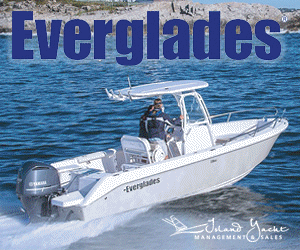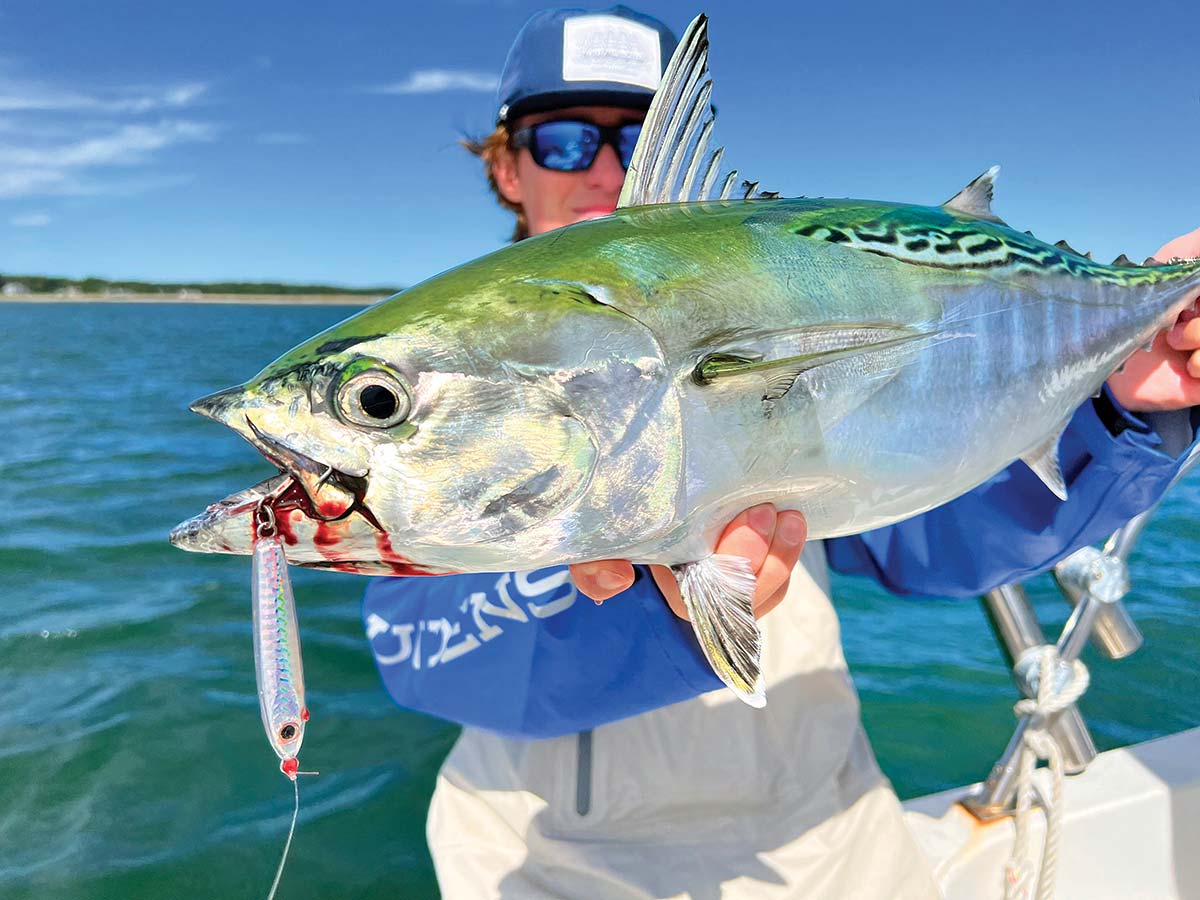
Whether your tackle box or plug bag, make sure to pack the metals this fall.
Metal jigs are one of my must-haves when September rolls around. They are extremely versatile in that they can be fished in many different ways, for a variety of species, and are simple to use.
Many of you may be familiar with metals like the Kastmaster, Deadly Dick, or epoxy jigs; these are all considered “metal jigs”. Metal jigs like these come with the assumption that they should be cast and retrieved, looking like a wounded baitfish along the way. However, as many anglers have found through generations of fishing, these lures aren’t just for casting, but also for jigging, blitz fishing and trolling.
Jig Styles
I like to classify metal jigs into five loose categories; diamond jigs, epoxy jigs, “fat” jigs, “slender” jigs and “casting” jigs. Diamonds and epoxies are pretty self-explanatory, most reader will know those by sight. “Fat” jigs are things like Kastmasters or anything else with that classic ‘peanut bunker’ profile. “Slender” jigs like the Deadly Dick or Pt. Jude Po-Jee are long and thin and make a good mimic for a sand eel. Casting jigs are things like the Shimano Currentsniper, Daiwa Zakana or the old standby Hopkins. There are certainly others that I didn’t mention – slow pitch for example – but that just goes to show the wide range of jigs that can be grouped together as metal jigs. I classify my metal jigs this way because each one has a “prime” situation, yet they are all versatile enough that they can be used in almost any situation.
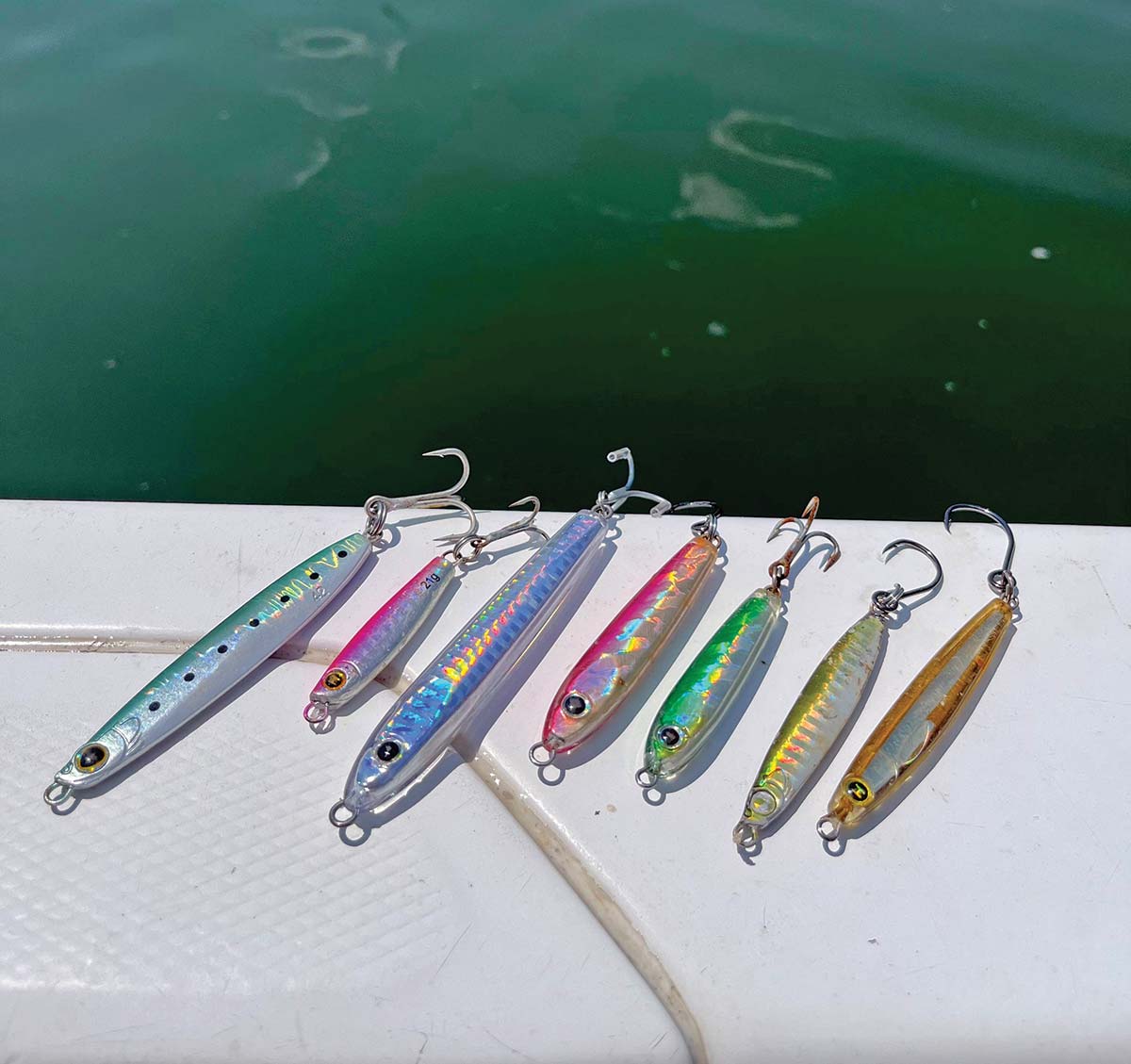
Casting jigs are very popular around the world and are gaining traction in our Northeast fishing market as well. These casting jigs are very versatile in that they can be used on blitzing bass and blues, jigged over structure for sea bass and porgies, and cast for hardtails like bonito, Spanish mackerel and albies. I will always have some sort of casting jig tied on to one of my rods, regardless of the time of year. These jigs represent a lot of the smaller bait we have in the late summer and fall, but larger sizes represent bunker and herring as well. Sand eels, peanut bunker, bay anchovies and silversides are all what I consider “small bait”. These jigs work great when you find bass and blues blitzing on smaller bait.
Epoxy jigs may be the most versatile jig on the market today. They’re quite similar to the casting jigs mentioned above, but are encased in a layer of epoxy, which essentially protects the jig from toothy predators and provides a natural refraction of light. Epoxy jigs have a common theme in that most anglers use them for hardtails. However these jigs are also great for pounding the bottom, as the coating better protects the paint from chipping on rocks and structure. Heavier epoxy jigs like the Game On Exo Jig 1.5-ounce are a great option for jigging the bottom or when fished vertically for bluefish, stripers, sea bass and other suspended fish. Like casting jigs, epoxies represent a large majority of smaller baitfish in our waters year round which makes them a solid year-round option.
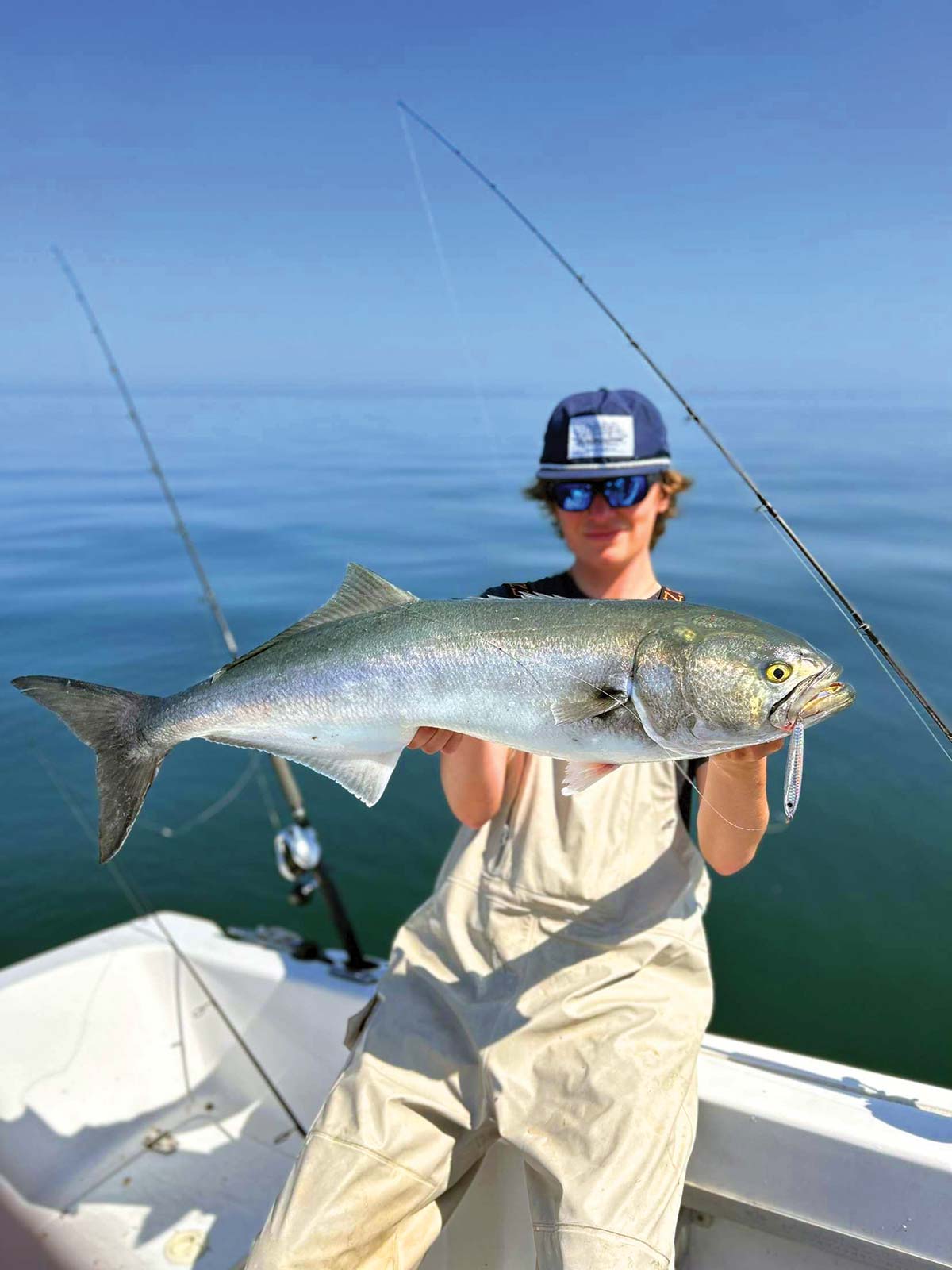
Bass & Blues
| AN ALBIE ASIDE |
| When waiting for the albies to show, try dropping your metal or epoxy jig to the bottom and jigging to pass the time. I have landed a long list of species while ‘jigging in place’ waiting for albies; porgies, sea bass, weakfish, fluke, stripers, blues and even tautog will take a shot at your jig. My go-to bait for this purpose is the Shimano Currentsniper 28, 35, or 42-gram in real iwashi and brown aji. |
Striped bass and bluefish can be caught in many different ways, however I would argue that fishing a metal jig is the easiest, most user-friendly and fun method for targeting this dynamic duo. There are three scenarios where a metal jig is my top pick for bass and blues: rain bait blitzes, suspended fish on small bait, and fall run surfcasting.
Rain bait, snot bait, or micro bait is what we like to call “small” bait. Rain and snot bait are usually juvenile fish like bay anchovies, silversides and peanut bunker. Vast schools of these tiny baitfish will flood Northeast and Mid-Atlantic waters from late-August through September. These small bait blitzes are often infuriating for anglers because stripers and blues are dialed in on smaller baits that most lures can’t match, often resulting in a very picky bite. Jigs excel here because they are heavy compared to their size, they accurately match the size of the bait, and boast the casting trajectory to reach distant blitzes. In blitz scenarios, my top three are the Game On Exo 3/4-ounce in silver, Hogy Heavy Minnow 14- or 21-gram in olive, or the Shimano Currentsniper 21-gram in real iwashi. Fish these jigs with a moderate retrieve, keeping the jig just below the surface and in the strike zone.
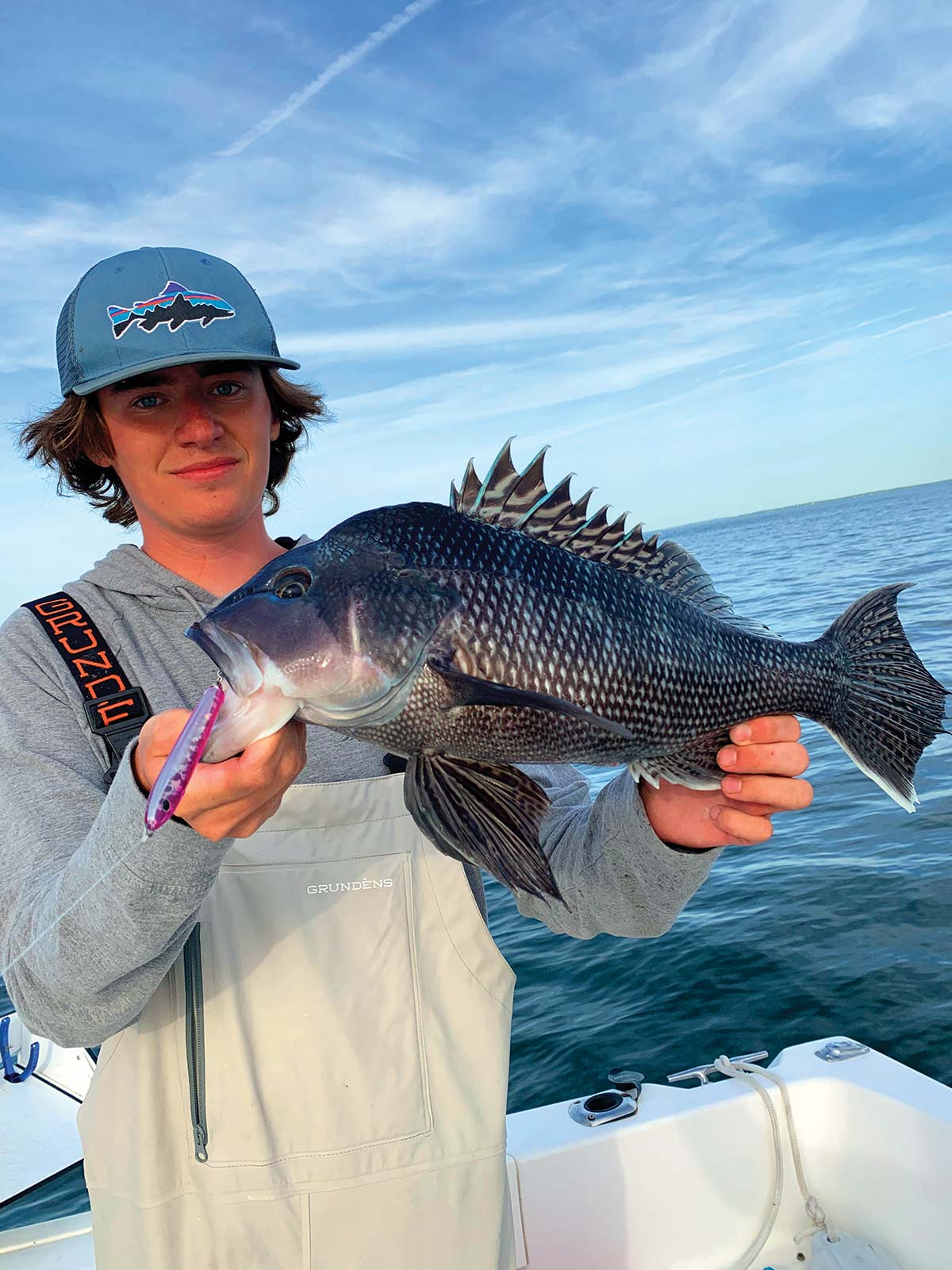
Usually what happens when a small bait blitz subsides is that the stripers and bluefish will descend into the water column and suspend, waiting for the baitfish to regroup. When these fish are suspended, they are waiting for a quick and easy meal; that’s when a metal jig works best by boat when dropped down and jigged vertically, with sharp “snaps” of the rod. This imitates a wounded or lone baitfish, that the bass and blues make quick work of. Here I like the 1-ounce Game On Exo Jig in silver or gold, the Daiwa Zakana 30- to 40-gram in maiwashi, and the Shimano Currentsniper in 35-gram in real iwashi or brown aji.
If you’re met with a blitz scenario in the surf, a small metal jig will still do the trick. Once again, their weight to size ratio makes them a great choice for surfcasters because you can deliver a tiny offering a long distance from the sand or rocks. How many times have you run into a blitz that was ‘just out of reach’ of your typical plugs and plastics? Tie on something like the 3-inch Hogy Heavy weighing 2 ounces and watch the line melt off the spool. Try mixing up fast and moderate retrieves to figure out what the fish want and then reap the rewards of the long-cast metal jig.
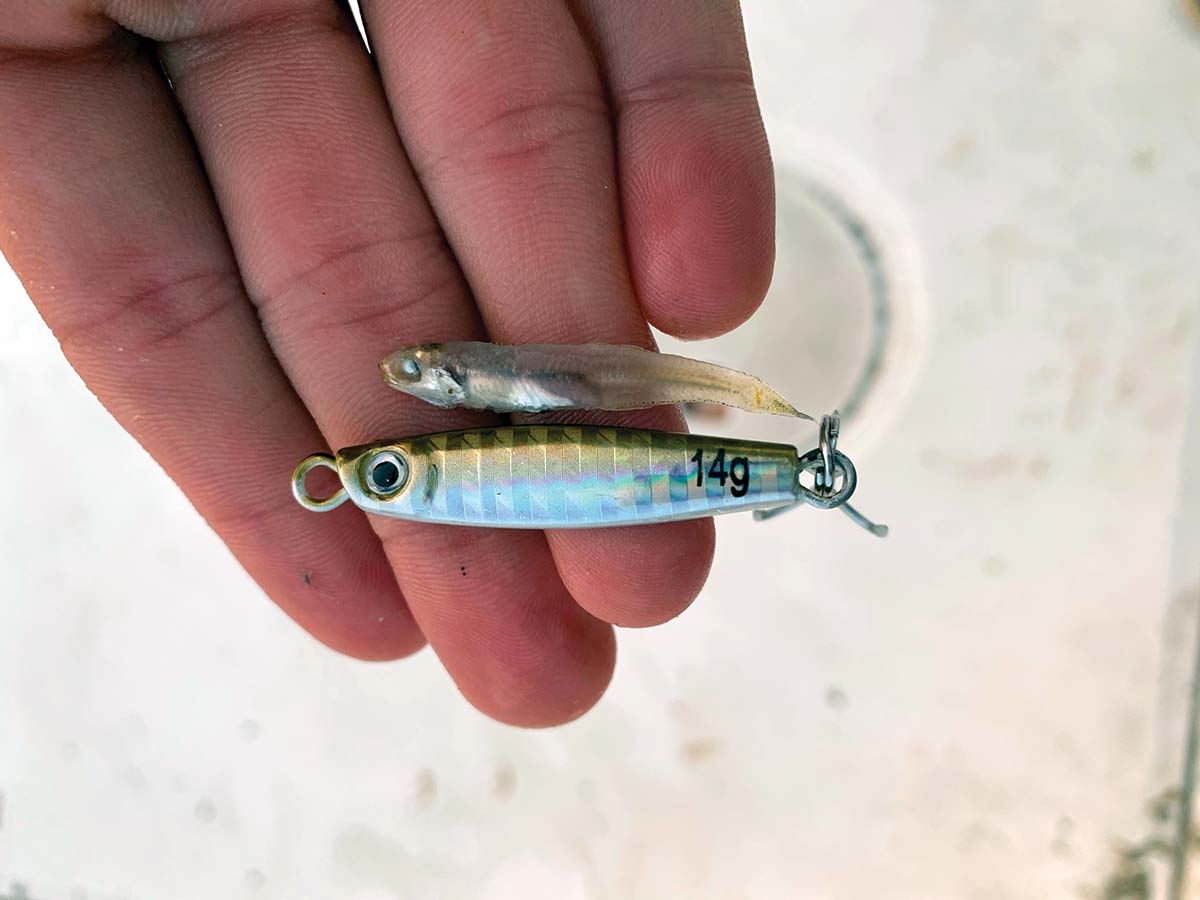
Fall Running
Metal jigs are definitely the most popular lure to use for hardtails like false albacore, Atlantic bonito, and Spanish mackerel. While epoxy jigs have gained the most angler attention when it comes to albies in particular, casting jigs are also very effective, and are definitely underutilized. Metal jigs are the “perfect” lure to use to catch hardtails because they can be cast far, replicate the small bait hardtails often feed on and are easy to fish, requiring little more than a rapid retrieve. I’d recommend the 1-ounce Game On Exo Jig in silver or pink, Shimano’s Currentsniper 21- or 28-gram in real iwashi or blue pink, or the Hogy Heavy Minnow 21-gram in pink, olive or silverside. Fish these jigs at a medium-fast retrieve, with the rod tip low to the water, casting into blitzes or pods of hardtails.
Metal jigs can catch about any species of fish you can imagine; I’ve caught striped bass, bluefish, sea bass, porgies, hardtails, weakfish, fluke, tautog, winter flounder, cod, haddock, pollock, hake, northern kingfish… and the list goes on. In fact, metal jigs can really be used in almost any application, jigged and casted for almost any species of fish you can catch in our Northeast and Mid-Atlantic waters. I even use the same 3/4-ounce Game On Exo Jig I use for albies, through the ice for lake trout. They are very versatile and readily available at most tackle shops and outfitters.
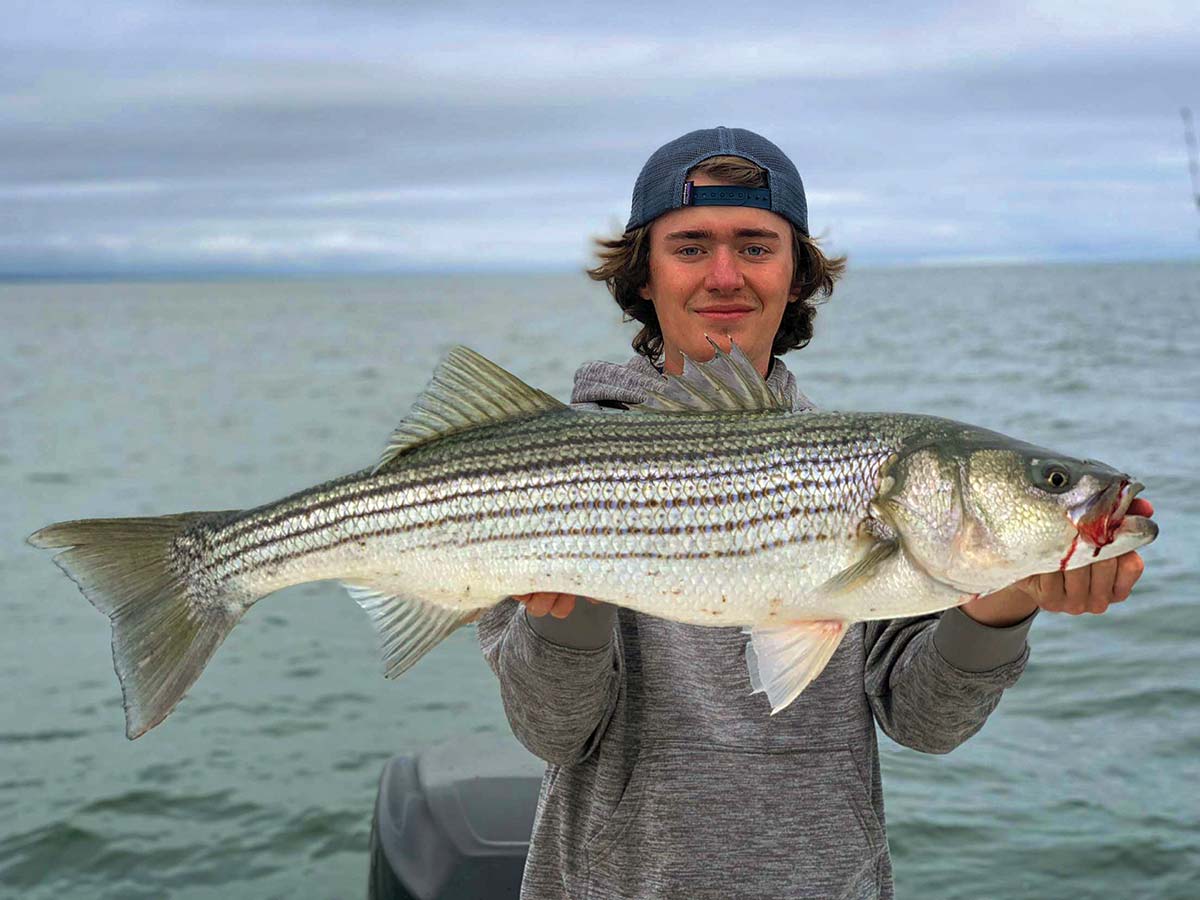
My go-to setup when using metal jigs of all sizes (21 to 60 grams) is the G. Loomis ProGreen (PGR944S) paired with a Daiwa BGMQ 4000 spooled with 20-pound J-Braid 8x Grand. While I do love my G. Loomis setup, you don’t need anything super crazy; a medium to medium heavy 7- to 7-1/2-foot inshore spinning rod paired with a 4000 to 5000 size inshore spinning reel is ideal. The light action of the rod makes casting lighter jigs a breeze and is plenty of fun when hooked up to smaller sized fish. A setup like this can also handle bigger fish, such as over-slot stripers and burly bluefish.
| BOTTOM BOUNCING? |
| Fishing for porgies (scup) and sea bass was once thought of as a ‘bait only’ scenario, but as the industry has continued to put out lighter and more capable outfits, anglers have found that fishing for these species with jigs is even more fun than bait. Try jigging along rocky bottom or around wrecks and you’ll be quickly convinced. Metals are cheap and easy to jig for kids and adults, and they don’t require breaking out a cutting board to prep bait. Drop your jig to the bottom, and “snap” your rod upwards with a sharp jerking motion to make the jig bounce and flutter along the bottom. Be sure not to allow the jig drag bottom; otherwise the day could get expensive. I’d recommend using the 1.5-ounce Game On Exo Jig in pink or electric chicken, the Daiwa Zakana 40-gram in blue/pink or pink, or the Shimano Currentsniper 42-gram in blue/pink. |
When it comes to braid, I prefer something in the 10- to 20-pound range, and generally an eight carrier line such as Powerpro Superslick, J-Braid 8x, or Suffix 832. Smaller diameter braid increases casting distance and cuts through the water more efficiently, making it easier to fish deeper with the light jigs.
With the fall run approaching, smaller bait becoming more plentiful by the day and hardtails beginning to show, many of us will have metal jigs tied onto our rods for the hope of running into a pod of hardtails. So why not drop those jigs down to jig for bottom fish while we wait? Some of us will run and gun chasing pods of albies, while others, myself included, will wait in the area for the pods to show themselves, jigging those metals to pass the time with the hope of coaxing up whatever is down there and willing to eat.




